You give up a lot for some very specialized advantages, but this is perfectly fine with me, because of what you gain.
The first part of this is simple: I don't like feeling bad winning. And, most of the time, fielding the infamous Deathjack or Tartarus ends up feeling like I've cheated*.
The second part can be summed up in one, seemingly self-explanatory term: Theme List. While this term should be self evident, it isn't. The vast majority of Theme Lists fall short in one or both areas: They don't mesh well enough with the world background to be considered thematic, or they simply aren't well-designed enough to be a useful list.
The third and fourth elements are simply a matter of taste. Third, I like a limited number of options, so I can master them. Fourth, I like steampunk. In an arguably steampunk** game, I like my zombies steam-powered and scientifically augmented, not with scary magic and medieval axes.
Also, I've done some more work on my Cryx recently, but haven't had a chance to reshoot them. My thought is, decent pics are better than no pics, so bear with me, until I clean this up.
Without further ado, on to the discussion.
*No offense, Cryx players, I casually play Cryx, but I don't see how anyone can, with both experience and a clear head, say those pieces, in their current state, are good for the game.
** I feel this is actually a bit of a misnomer. While clearly Steam, I don't think Warmachine is actually Punk in any way, but calling it a "Steam" game sounds dumb, so, there.
Stats
Good, average, average, average.... the little War Witch that could(n't quite) has the mediocre stats you'd expect from a spell slinger. You won't be relying on these much, I find.Deneghra's high SPD is one of her best qualities. While usually not used to get in a juicy charge, it is nice for outflanking an enemy or getting in the perfect position.
Deneghra's decent melee capabilities are hamstrung by her decidedly low MAT, but that's fine, since she's a spellslinger and can jump out of melee, if necessary.
Deneghra's DEF is a selling point. While not the highest echelon, it's well outside of reliable for anything but the most accurate attacks from hitting. Watch out for anything that can boost or combined attack, though. A simple hill, forest, or wall can catapult this to frustrating levels.
Deneghra's ARM (and health) is another painful point. While it provides more armor than you'd expect, it still isn't something to be proud of. Blasts can and will hurt.
As you'd expect from any spell caster without one amazing gimmick, she has a solidly high FOC. Using this wisely is going to be a lot of how you win games.
Abilities
Cull Soul used to be remarkably easy to exploit in MkI, but, these days, the young witch will have few souls coming her way. Most of what this does is deter opponents from swamping Deneghra with weak enemies, if they remember the ability even exists. However, ending with several weak models in range of Venom is already a bad idea, so you're probably winning or have just survived an assassination attempt, if that's the case. Situational, but don't forget it.
Parry is absolutely great for Deneghra. There will be few ways to pin her down in melee, which is exactly what you want for a spell caster. This also means that, if you're able to exploit it, you can run straight through a gap in your enemy's lines, for an offensive push.
Shadow Bind is another highly situational ability you shouldn't forget about. Most Cryx pieces have a high enough MAT that the penalty from getting hit isn't worth exposing your warcaster, but there are definitely times when spending one focus to be sure Deneghra hits is worth it, if you need something hit and dead, and don't have a better or more efficient way of doing it. There are definitely scenario points where preventing advances is useful, but, again, that's a lot of risk when you have other means of slowing down your opponent.
Don't forget that, while she has a pretty embarrassing MAT, Sliver does decent damage, especially if you start stacking it with spells: While I've never tried it, I have a theory that Deneghra could, under the right circumstances, become a very competent melee assassin.
There's little defensive reason to use Shadow bind, since you already have Parry.
Yes, that little bar code looking thing on the front of Deneghra's card appears to mean she's Stealth. She already has a pretty high DEF, but another layer of defense is always nice. Again, blast damage is something to watch out for, so don't take shelter behind something with a low DEF. Also, remember-- sprays trump stealth! You've still got a high DEF, but most sprays, if they make contact, will hurt.
Spells
Crippling Grasp is one least pleasant experience I've come up against. There are a lot of things going for this spell, but the big one is that it fulfills two roles: it both offensively and defensively weakens the piece(s) by that critical two points of stat. While it does less against enemy ranged potential, there is not a model I can think of that doesn't notably suffer from the loss in both DEF and ARM.
There are a few approaches to using this spell:
One is the short term approach: cast it on what you want to immediately die, or what you want to set up for the kill during the following turn. If it survives, it'll be at lower offensive stats.
Another is the long term approach, usually only if there's something you're really scared of. Cast it as early as you can, possibly sacrificing an arc node in doing so. If you've prevented any ways of negating upkeep spells, then, for one focus a turn, you've effectively given yourself an extra 2+ turns to deal with the rest of the army before that monstrosity hits your lines, and, when it hits, it will probably not be in top shape. The big disadvantage of this is simply, if you want to change targets of CG, you're losing a fairly serious investment.
The third involves being very mean during your feat turn (discussed below).
Ghost Walk is a powerful board control ability. Obvious uses of this include bursting through a forest or obstacle without penalty or disengaging your arc node. I don't take advantage of this as much as others, but I also tend to play anything as a weird combined-arms list with an emphasis on range, so I'm probably not using this as aggressively as its meant to be.
NB: Ghost Walk does not allow you to move through models, nor does it allow you to charge without line of sight. Don't think of this spell as more than it is! Most of the time, it'll be acting like Pathfinder or Parry.
Influence is yet another hit or miss ability. Two thirds of the time, it'll be useless and you won't use it in a game. The other third, when you're up against someone who relies on Reach and/or Shield Wall, you'll be laughing all the way to the bank.
While cheap, there's a reason it's so cheap, and it's not just limited utility: a regular attack will require a hit and a damage roll. This one requires two hit rolls, followed by a damage roll. This is one more chance to fail. Against anything with a decently high DEF, you'll likely want to be casting something else, instead. Ideal targets are Shield Wall Medium-based units, as these tend to have low DEF, bunch, and have high MAT and damage output.
Parasite often feels like Crippling Grasp's weaker twin. In exchange for hamstringing offensive potential and lowering DEF, you get one more point knocked off of the ARM and a +1 ARM, which brings Deneghra's up from "useless" to "worthless." I'd only use this if you can't switch out Crippling Grasp, and, given the cost of each, I'm not likely to cast both in the same turn. Maybe I'm missing something, but I don't usually see a use for this.
Scourge is mostly only useful for the knockdown ability, as it costs a ton for a decent attack, when you have Venom at such a great price. The best part of Scourge is that you don't need to hit to knock down. This is best in situations where, either you need a lot of stuff knocked down (and lowering their defenses isn't a better option) or a lot of high DEF stuff killed (and 2 Venoms won't do).
While pretty straightforward tricks (at least, from the perspective of a Magnus player), two ways of hitting high DEF pieces with less effort are:
-putting something with a low DEF and its back turned (i.e. a mechanithrall) that's either disposable or tough enough to take it, next to your target (but not engaged/engaging)
-getting your arc node as close as you can: AOEs deviate a maximum of half the distance between attacker and target, so, if you get close enough, you're guaranteed to hit with the blast.
Along with Parasite, Venom is my workhorse spell. FOC 7 will hit most things, and POW 10 will make anything short of a shield wall melt (and Corrosion will help on anything tougher). I tend to take fairly little anti-infantry in my list, simply because repeated castings of Venom will tend to clear out most chaff. This, as with most things, becomes notably better under the right circumstances, which you can make sure happen.
NB: Venom is almost as effective against models that can't be targeted by magic as the regular variety. The simplest method of indirectly attacking your magic-invisible enemy is to attack something taller that's behind them. Even if the vast majority of your opponent's army is immune to targeting, there'll likely be a warjack or support piece to "target" behind the front lines.
The other method is to use your own piece by positioning it where you'd like it to go. A Bonejack is a pretty safe bet, as you need a high number to make contact, though, if you want to risk less, a mechanithrall will do just fine.
Feat
The Withering is one of those few unholy feats that effectively works two turns and, in this case, it works very well.
Basically an expanded Crippling Grasp, this feat is (in my opinion) one of the nastiest in the game. This is also why I'm perfectly fine not taking Cryx's best and brightest (or, at least most brutal) pieces with Deneghra.
My feat turn typically looks something like:
1: put 3 focus on whatever will use them best
2: move up an arc node (and make an opportunistic attack)
3: feat then boost a Crippling Grasp at whatever must die
4+: variously clear a path to what needs to die, kill it, mop up
The first part of the feat turn is the feat itself: everything in your army will be notably more effective, and your opponent will be in a likely terrible position to retaliate the following turn, as, along with the loss of stats, the loss of charges, 2 focus (and everything that implies), and special attacks will mean that your opponent will have few means of effectively fighting you. This makes The Withering not only devastating, but relatively forgiving, as your opponent will have a weaker turn to follow.
NB: there are some feats that can circumvent some of the penalties, here. You should pay close attention to these. Also worth noting is that, while the accuracy decreases, ranged and magic attacks lose none of their punch. Some opponents will use their feats reactively to counter what you've done, occasionally you'll need to use yours to counter theirs, and rarely, your opponent will be able to push straight through your feat.
Probably the best way to counter your feat is any ability your opponent has to get extra movement or range from their feats (or spells, for that matter). A huge portion of your feat is the ability to control your fight, which is why I engineer my Witching Hour lists as skirmishing armies. The more you're able to control the battlefield on your feat turn, the more likely you'll take little damage in the following turn.
The second part of your feat is your Crippling Grasp target. 4 points worth of stat difference is immense. For defensive stats, your army effectively gets +4 to hit and damage against your target: this is slightly more mileage than a boost to hit and damage for every attack. The more attacks you can get in, the more devastating this becomes, which is why range and magic are so essential to this list: you will virtually always be able to get more attacks in this way.
As a point of reference, the humble Mechanithrall becomes MAT 9/P+S15 (if making 2 attacks) or P+S 19 (if making 1 attack). This means that they're hitting around as hard and accurately as a heavy warjack, for half a point per model.
Returning to the above comment on the relative safety this feat ensures, your target, should it survive, will be at severe penalties. Melee pieces will be much weaker and less accurate, while spellslingers will be both less accurate and have fewer focus to spread around.
About the only targets that are relatively unscathed are long-ranged and relatively accurate ranged pieces or spellslingers that don't rely on FOC. With these, simply engage them to limit their retaliation (probably mostly to repositioning and killing what they can).
Composition
The theme list will effectively dictate this for you. Tiers 2 and 3 will mean you're taking:
4 solos
5 bonejacks (3+ arc nodes)
…Which is a bare minimum of 9 points(+5 used for WJ points), but more likely will come to at least 19 of your points (again, plus WJ points).
Additionally, I feel kind of naked running without at least 1 heavy, even with Deneghra's means of enhancing your army indirectly, which will put your list at 25+ points. You can squeeze this in to a 25 point game, but will probably start feeling more comfortable at 35 points.
I'll add more to benefits of the theme list in individual entries and below
Arc Nodes(!)
Our brave Warwitch lives and dies by these small, armless warjacks. You'll want at least two, preferably three in your army. I tend to run 35 point games, so am not going to comment on the necessity of arc nodes in larger games...
The humble Deathripper always has a good home. While often overlooked because it's an arc node that needs to be in melee, therefore inefficient, I consider this to be versatility instead. For a light warjack, this model has above average P+S, and on feat turn, a P+S 18 sustained attack is nothing to sneeze at. While 2+ tends to feel like a waste, one of these tends to be a strong opportunistic killer. You can take advantage of your opponent's ignorance in thinking that engaging the arc node will end its threat.
The Ripjaw is more threatening and has obvious synergies with Deneghra's abilities: you subtract after you divide for armor piercing, so each point of armor you've taken off effectively acts like two. Where the Deatheripper's melee abilities are a backup, the Ripjaw wants to be in the fight. I find them a little expensive.
The Nightwretch's AOE is notably more powerful under the right circumstances, as, again, blast damage interacts favorably with armor penalties, but I don't find the focus required for blasts to be worth it, so the little bird-heads are often side-lined.
The Defiler is often my jack of choice, and I often find myself taking two of these. One of the nicest abilities they have is a spray that's the same range as Deneghra's. While not quite the same, if there are some moderately tough enemies clumped together, a few sprays should soften them up well enough. Flanking with these can devastate your opponent, and sometimes they'll forget that Venom isn't the only spray they need to face, clumping magic-immune pieces, if you're lucky.
Bonejacks
The Stalker is just as fragile as always, but Deneghra's spells will make the target soft enough that it's a bit more trouble than usual. The same can be said for the Scavenger. Simply because I don't believe in overspecializing, and because more targets that can use focus are nice, I'll tend to take some melee bonejacks once I've gotten 3 arc nodes.However, if you're finding that either, you're getting your arc nodes killed (or otherwise stalled) too quickly or you're getting a ton of mileage out of them, 4+ are fine in a list like this.
Addendum: Something that slipped my mind-- the Ghost Walk and Scavenger's Flight combine for a pretty nasty charge, ignoring (I believe) everything but Line of Sight. I still like running Stalkers 'cause I have 2 and think the models look great, but this is a strong argument for Scavengers.
I have no particular love for or experience with the Helldiver. I'd be happy to add any input suggested here.
Melee Helljacks
The Seether is like a Slayer, except better in every way but cost. Unfortunately, this is the kicker. I find that, if I'm going to spend that much, I'm probably taking only one heavy, and it's probably going to be something that sacrifices raw hitting power for versatility.
Ranged Helljacks
I'm a very strong proponent of ranged jacks. They come at a premium, but their flexibility means they have a lot of utility, and force your opponent to react. Being Cryx heavies, they have strong melee abilities for later in the game.The Corruptor is, unfortunately, a warjack I have no experience with. Sorry, can't comment. If you have something to add, pelase do!
The Reaper benefits in the same way as anything else does, but this also makes its decent harpoon much more reliable which, in itself, gives some solid synergy here. Sustained attack with a solid P+S and armor penalties, of course, has a lot of value.
The Desecrator, again, is a warjack I have no experience with. Sorry, guys.
Harrower: thresher will benefit from unit-wide or army-wide debuffs, and, frankly, is a solid choice. The reason I don't usually pick this guy is because there are enough sprays in the army that I don't feel I need that level of anti-infantry.
The Leviathan is my heavy of choice: Three shots will benefit from her feat/CG combo. This is great for cracking armor, and has the advantage of, in being ranged attacks, having a much wider threat zone.
Units
Bile Thralls suffer from the same problem as the Harrower, in that they're useful and benefit more from weakened defenses, due to higher volume of targets that can be hit by one attack, but I tend to already have enough sprays that these aren't priority choices.Mechanithralls are a strong choice, in my mind. Their two weights of attacks give them the versatility I enjoy, and they're strong under Deneghra's various offensive aids. Unfortunately, they don't benefit from much defensive help, so they're still fragile.
Solos
Necrotechs (& scrap thralls): Necrotechs are strong support pieces for ranged heavies. I'll have one tag along with each of mine, providing a little aid with attrition. I don't feel scrap thralls are worth it at all, simply because, for the same cost, you get a Necrotech.NB: As written, one choice is still multiple solos, for T2 benefits. This makes Necrotechs more useful. This is also the only reason I would pick scrap thralls: if you're going for a higher tier, one point is great for three solos, if that's all you can spare.
Pistol Wraiths are fantastic with Deneghra's abilities. They go from solid harassers to lethal hunters and assassins. I usually take one with her, though the only reason I don't take 2 is because I find myself strapped for points, and they're pretty fragile, still.
Deneghra's Skarlock Thrall may be her best friend (even over Professor Asphyxious and her classmates from the Warwitch Vocational College). Simply put, you get one extra spell a turn. I tend to run him conservatively, until my Feat turn, where he's up front with an additional Crippling Grasp (if I want to change targets or have failed casting it due to poor planning or dice) or Venom (since it's just that good).
Warwitch Sirens are very nice with Deneghra. More Venom and Power Boosting is great. Giving Heavies Advance Move and having Advance Deploy are both useful, but you should be sure not to overextend the first turn.
Composition and Optimal Tier Size
Tier 2 is also not very impressive. Deneghra runs well with solos, so it may be worth it, but still is nothing to seriously sacrifice composition for.
Tier 3 is where things get interesting. To get the most of this, you could take 12 points (3 helldivers) to get 5 points (expensive bonejack), but I find myself typically spending 17 points on this. This tier will define your play style, and, if you aren't interested in using a bunch of disposable bonejacks to outmaneuver your opponent, this list probably isn't right for you.
I will only take this list at T3 because, 1- it's the best benefit and 2- I don't like to half-ass going in to themes, and will rarely go below T3.
My typical base T3 requirements will look like:
Deneghrawhich gets to 20 points.
-3x Deathripper/Stalker/Scavenger (usually 2 of the former)
-2x Defiler/Ripjaw (usually 2 of the former)
-Skarlock
Pistol Wraith
Warwitch
Necrotech & Scrap
You could play this at 25 by swapping stuff around and taking out 1 point, to add in a Slayer for a little hitting power, or accept that your army will fold under direct hits, and take some Mechanithralls or more solos/bonejacks. Neither is optimal, but both are viable.
At 35 points (I feel most theme lists start really working at 35), you could fit in 2 heavies (I'd go with a Slayer and a Leviathan, personally) or a heavy fill in the rest with whatever. Obviously, I feel that, at 35, at least one heavy is worth it.
Personally, I like the feel of Mechanithralls and don't like running without units, so I'd probably go with a unit or two of Mechanithralls plus a heavy.
Tier 4 is viable at 35 points, but I feel like it isn't necessary. Advance Move will get your heavies overextended, so I just use it as a free focus so I don't need to run. Since Deneghra isn't going to be doing a lot with her spells on the first turn, this isn't much of a bonus, especially because I usually have 1-2 bonejacks hang back for reinforcements when the first one(s) go down.
Because of all of this, your army composition is mostly dictated by theme, and it's a matter of which finer choices you want to make, and, whether you want to fill in your list with heavies (small army), bonejacks (bonejack swarm), infantry (light force) or a mix (well-rounded).
Notes on Potential Trouble Matchup/Elements
Accuracy
There are a lot of things that fall in to this category. They include:
-Various ways of auto-hitting (electroleap, blasts under the right circumstances damage effects, some feats)-Anti-Stealth (including Sprays, Legion, and Gunmages as the worst common offenders)
-decent-to-high volume of high raw or modified accuracy (pieces able to boost to hit, snipers, fully kitted-out Winterguard might be the worst offender, here)
The problem with Cryx in general and Deneghra's list in particular is, all of her direct offensive abilities rely on her or her bonejacks, which have good defense but terrible armor.
The best ways of dealing with these threats are outmaneuvering your enemy, threat saturation, and our feat turn. You can also stall by running a juicy target at them and hoping it distracts them, but this obviously depends on the rest of their army and if they take the bait.
Anti-upkeep
Epic Eiryss is the biggest offender here, though there are others.
In practice, dealing with these thrats is simple: don't rely on your upkeeps for anything other than an assist on the kill, and plan accordingly. You'll still typically outmaneuver your opponent, and your feat will still shut most things down, if you need to avoid retaliation.
Strong ranged lists
This is one of your biggest threats. Simply put, you'll probably be outgunned by certain lists, and, if you're outgunned by accurate lists, you may be in trouble. Sometimes the answer, being cryx, is to just rush them. You have the speed that you can go straight for the jugular, and if one threat gets through, you may be able to pull off a win. You're not going to win through attrition or firepower, in all likelihood, so you're likely looking for the high-risk/high-reward assassination run WM is known for.
Anti-magic (specific)
This is covered in Venom's notes. In short, be more creative or target other things. This isn't much of a liability, in the long run. It just forces you to think more.
Anti-magic (area)
There are a few abilities which punish or prevent spell use. This is a tough one, with your three major options being:
-Eat the penalty. Simply put, a little damage can be worth it for the offensive or defensive bonuses you want or need.
-Arc Nodes. A lot of anti-magic effects only work on the caster, not the arc node. Know how they work, exactly.
-Your Skarlock (or Warwitch(es)). If things shut down arc nodes, these are disposable ways to use spells.
-Feat. Like so many things with Deneghra, her feat is a good answer. This may allow you to outmaneuver whatever debilitating effects there might be, to either take it out or avoid it.
-Power your warjacks. 7 focus is a lot for raw attack and damage output. There may be times where Deneghra is primarily just a focus battery. It may not be the most efficient, but don't forget this option.
Victory Conditions
Force Multipliers/the basics.You have the tools to make anything in the game slower, weaker, less effective, and less durable. Use this to your advantage, turning moderate power to dangerous power, strong attacks to lethal ones. You can slow down retaliation and increase killing power.
NB: even if you don't accomplish what you set out to do on her feat turn, the following turn could be quite ineffective for your opponent. A simple example: a Crippled, Withered melee warcaster will be at -4 SPD, so probably won't be able to engage you in melee, will be at serious penalties if they do, and will have less focus to compensate. Furthermore, any backup spells or guns they have will be less accurate. There are exceptions to this, particularly pieces able to move without a SPD stat, but it's still nice insurance.
This weakened second turn means that it's sometimes worth using her feat a turn earlier than optimal, simply because it will give you one decent turn, followed by a weakened opposing turn, then your next turn.
A key skill to her typical assassination methods is knocking down an enemy holding up a key arc node. Scourge is probably too expensive (and not necessarily precise enough) for this, but a simple boosted head butt can provide the answer. Unless you're willing to risk your Skarlock to ensure this works, you'll probably not be able to benefit from any debuffs, but you've got good enough accuracy that a boost should be enough.
Positioning/Objectives
You will likely be able to outmaneuver your opponent, by preventing their movement and by your natural speed. However, I fund she'll do better going for the straight kill than worrying about this.
The Ranged Kill
While Cryx armies aren't typically played with a ranged emphasis, the combination of Crippling Grasp and the Withering are what define her viable play styles. Specifically, general defensive penalties are just as useful at enhancing ranged attacks, which are inherently more flexible, because they don't need the same proximity to the target.
The speed penalties and charge/run prevention will often mean you'll be able to keep taking advantage of your ranged superiority against a primarily melee force. Proper positioning and elimination of enemy ranged support can mean you'll be taking little to no damage on your feat turn, of you're holding back and focusing on melee.
The Alpha Strike
If I haven't hammered it in enough, you'll likely get this, especially if you've got a speed bump. You may end up with a numerically inferior force, but you should have the volume of attacks to make up for this.
Conclusions
This list takes me back to how I've always felt Cryx should be played. This isn't full of high-powered weapon masters, immunities to blast damage (I like Satyxis, but don't think Force Barrier is good for the game), or the raw power of the Deathjack.It's an army of decent pieces that can be made to hum under your powerful master (and, if you screw up, will crumble in her absence), which is how I feel an undead army should function.

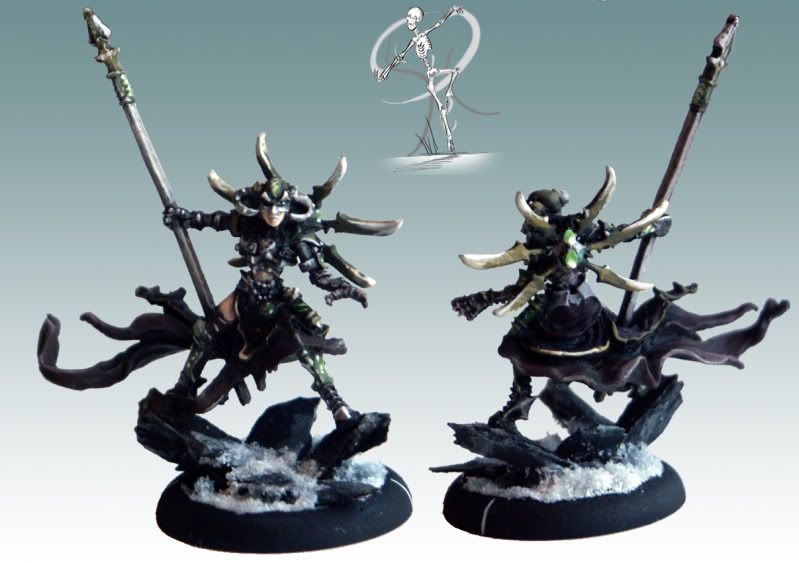
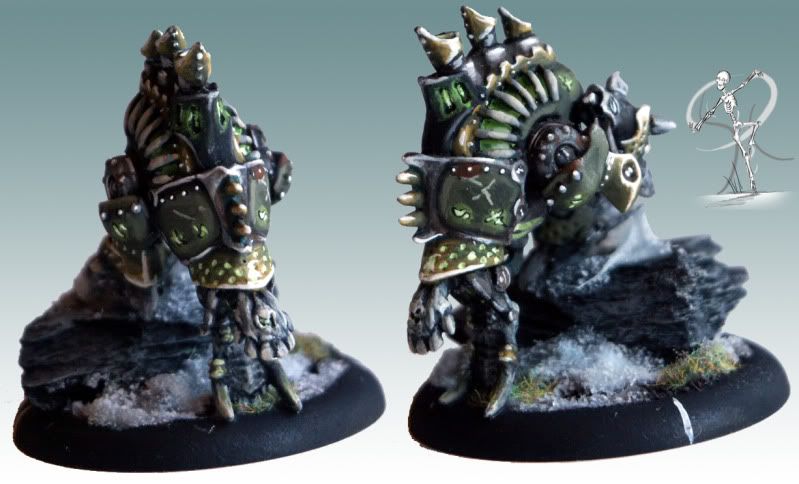
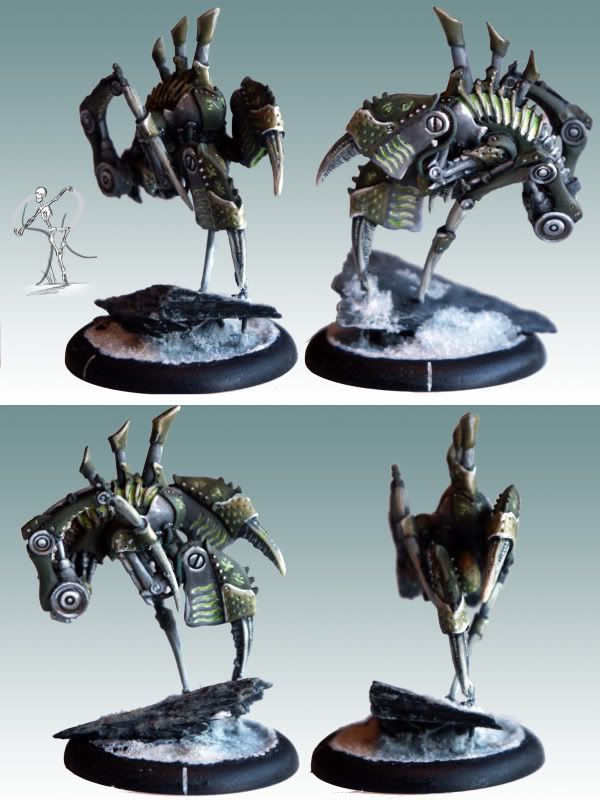
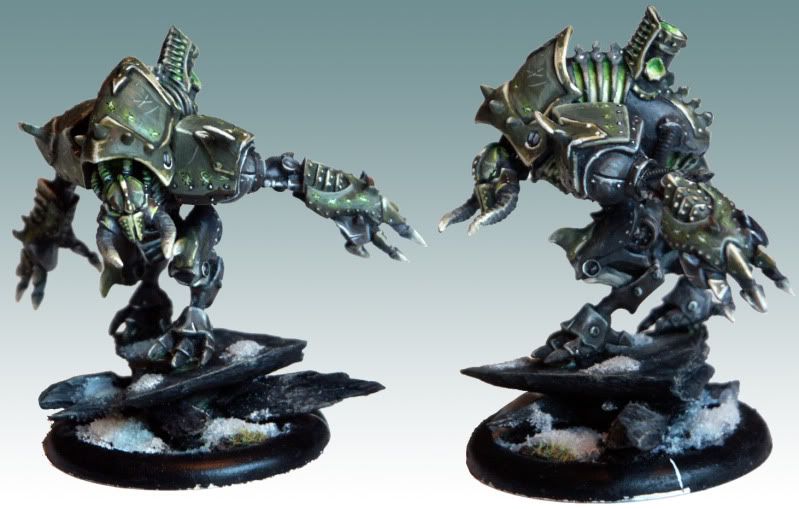
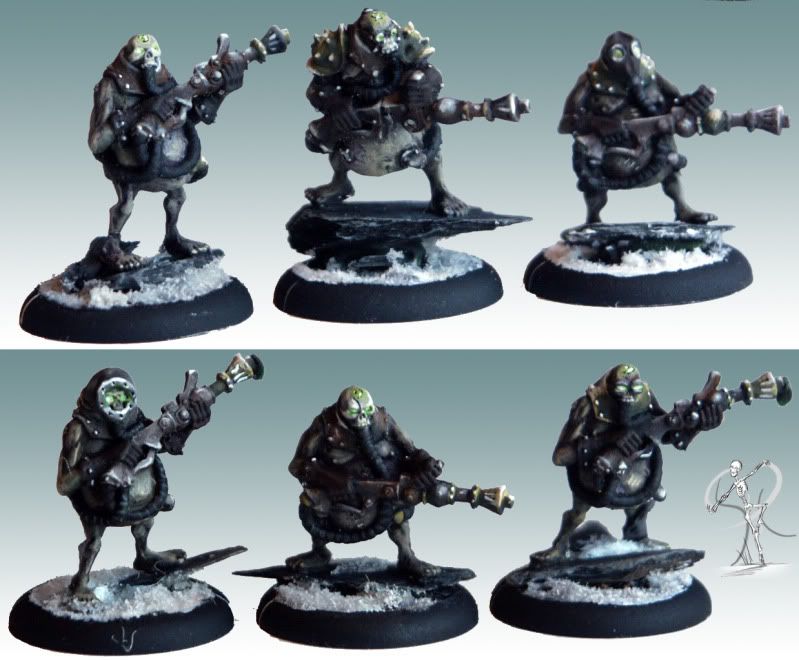
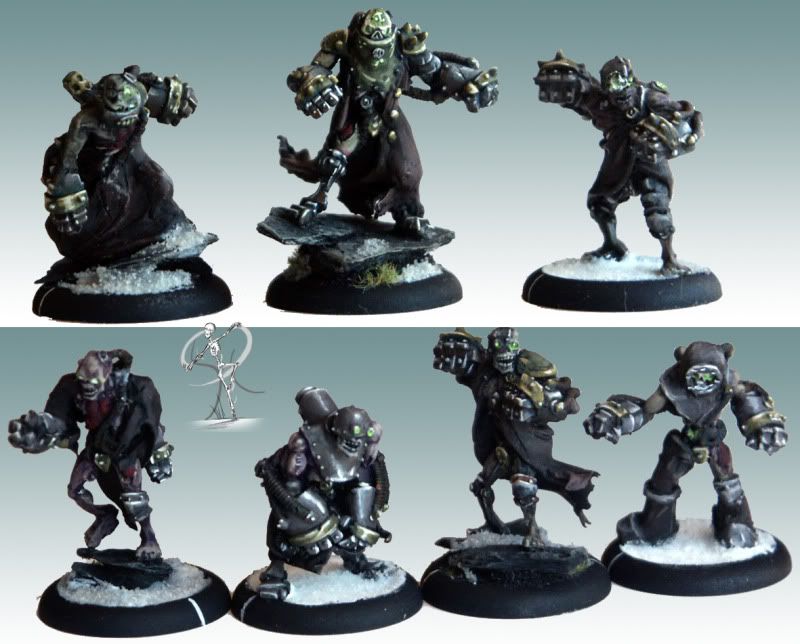
No comments:
Post a Comment